Embedded C welcomes you!
Dear readers, please note that this is the old website of maxEmbedded. The articles are now no longer supported, updated and maintained. Please visit the new website here and search for this post. Alternatively, you can remove .wordpress from the address bar to reach the new location.
Example: If the website address is http://maxEmbedded.wordpress.com/contact/, then removing .wordpress from it will become http://maxEmbedded.com/contact/.
We apologize for the inconvenience. We just want to give you a better viewing and learning experience! Thanks!
Hello folks! Now that you are aware of the different port operations in AVR, we can move forward to actually code our way right through it! Since we will be using C (in fact Embedded C), the best software is the AVR Studio 5 by Atmel. The latest version is 5.1 which was updated in February 2012. The best part is that it is very interactive, user friendly, has awesome UI and unlike other compilers, it is totally free of cost. You can download it from here.
For those who do not want to register in order to download, I am posting the direct download links of the images here. Please report to me if the links are not proper, I will update them in that case.
- AVR Studio 5.1 Installer (396MB) – Contains AS5.1, ASF, AVR Toolchain
- AVR Studio 5.1 Installer – Full (616MB) – Also contains Visual Studio Shell & .NET 4.0 (Download it if your system will not be connected to the internet during installation).
Those of you who like to learn how to use the AVR Simulator, you would prefer to skip this post and move on to the next.
You have been familiar with C (I presume). You have been working with normal data types and have been writing codes that run on a computer. But now, we will be using the same C (with some modifications) to run our microcontroller (MCU). The C used in embedded systems design is called Embedded C. Here, you will come across the same if, for, while, do while, case, switch, etc, but you will be introduced to newer data types (actually a modification of the existing ones), newer libraries, newer built-in functions and newer registers!
What do we need?
The following software will assist you in your work. You can download them from the links provided. We will discuss them one by one here.
- AVR Studio – to write, simulate, debug and emulate your code
- AVRDude – burns your hex code into the MCU
- FreeISP – GUI for AVRDude for use with AVRISP or USBtinyISP programmers
- eXtreme Burner AVR – GUI for use with USBasp programmer
Installation
Installation of these software is pretty straightforward. You should not face any trouble in it. During the installation of AVR Studio 5, it might need to install some other stuffs before the actual installation begins. If you face any trouble in installation, you are free to drop a comment below.
AVR Studio 5
Let’s have a look at the features of AVR Studio before we proceed.
- It is an Integrated Development Environment (IDE) for AVR Software.
- It allows chip simulation and in-circuit emulation.
- It supports the whole AVR family of Microcontrollers (MCUs).
- It has easy to use User Interface (UI) and gives complete overview.
- It uses same UI for simulation and emulation.
Creating your first AVR Project
Here is a step-by-step guide regarding how to create your first AVR Project using AVR Studio 5.
- After installation, open AVR Studio 5 from Start → All Programs → Atmel AVR Tools → AVR Studio 5.0
- After opening, you will see a Start Page like this. Click on “New Project…“.
- Then, you will see the following dialog box. Choose AVR GCC from the ‘Installed Templates’ pane, and then choose Empty Executable Project. Now, you can give any name to it, say MyFirstProject and choose an appropriate location in your hard drive. Check Create directory for solution. Click on OK.
- Now, you will see the Device Selection dialog box. As you can see, AVR Studio supports all the AVR MCUs! The list is huge! Choose your device from this list. We choose ATmega32. Click OK.
- Now, you will see the following screen. Note that the basic program structure is already prepared for you. You simply need to initialize your variables and place your code inside the while(1) loop.
- Congratulations! You have successfully created your first AVR Project! Now to further proceed with it, we need to write a code, which is discussed in the next part.
- Have a look at the awesome AVR Studio IDE. Feel free to explore the software. We will discuss some of the required components as and when necessary.
Writing the code
Now that you have successfully created your new project, we need to write a code in the AVR Studio Code Window. Let’s write the code for the problem statement discussed in this post. We will write the code for blinking an LED. The schematic for physical connection is given below. Please note that it’s just a schematic of the region of interest. For full schematic, view the circuit diagram of your development board.
Now most of you will copy and paste the code. But I suggest you to type the whole code. This will introduce you to a whole new feature! While typing any keyword or inbuilt function, AVR Studio 5 automatically displays a list of possible functions/keywords that you wish to type. You can select it and hit enter key. This increases your typing speed also (somehow!). Plus it also gives you greater confidence in writing the code.
#include <avr/io.h>
#include <util/delay.h> // for _delay_ms()
int main(void)
{
DDRC = 0x01; // initialize port C
while(1)
{
// LED on
PORTC = 0b00000001; // PC0 = High = Vcc
_delay_ms(500); // wait 500 milliseconds
//LED off
PORTC = 0b00000000; // PC0 = Low = 0v
_delay_ms(500); // wait 500 milliseconds
}
}
Code Explained:
#include <avr/io.h>is a header files which provides you with various i/o operations like DDRx, PINx, PORTx, etc.#include <util/delay.h>is a header file which provides you with inbuilt delay functions like_delay_loop_1(), _delay_loop_2(), _delay_ms(), _delay_us(), etc.- Rest of the code is simple and straightforward. For details regarding how to use DDRx and PORTx, view this post.
_delay_ms(xxx)provides a delay xxx milliseconds whereas_delay_us(xxx)provides a delay of xxx microseconds. There are two more types of delays which are used commonly,_delay_loop_1()and_delay_loop_2(), but to understand their concept, you need to be familiarized with timers, which we will discuss later.
Configuring AVR Studio 5
There are two things that you must configure in order to make your code run in your MCU in a better way.
- Setting up your clock frequency F_CPU
- Choosing Optimization Level
Setting up Clock Frequency F_CPU
This is a very essential step. This is because if you don’t set your clock frequency, the whole timing would go wrong. _delay_ms(500) will wait for 500ms, but it counts with respect to your clock frequency. If your F_CPU setting is wrong, it won’t wait for 500ms. It will either wait longer or for lesser time. By default, delay.h defines F_CPU=1000000UL (1MHz). UL stands for unsigned long. But this isn’t always the case. Check your development board if any crystal oscillator is present or not (across the XTAL pins). If it is present, note down the exact value of the frequency. If no, then choose either 1MHz, 2MHz, 4MHz or 8MHz depending upon the fuses set in your MCU (I expect that correct fuses must have been written. We will discuss about fuses later).
Note: You must set fuse bits for a new AVR microcontroller. These fuse bits will specify the correct clock frequency (whether to follow internal clock or external clock) and many other settings. They are set only once, and hence MUST be set correctly, or else you will render your MCU useless. To learn about fuses, view this.
Now, how to put? Well, the simplest way is to add the following code before including the header files.
#ifndef F_CPU #define F_CPU 16000000UL // or whatever may be your frequency #endif // remember to put it before delay.h // now include the header files #include <avr/io.h> #include <util/delay.h> // rest code goes here
You need to add it before every code you write. Or else, you can go to Project menu → MyFirstProject Properties (Alt+F7) → Toolchain → AVR/GNU C Compiler → Symbols → Add F_CPU=16000000UL to Defined Symbols.
Always check this out before compiling your code.
Optimizing your Code
You need to choose an appropriate optimization level for your code. Choosing the right optimization level will result in smaller hex file and faster compilation time. You can do it so by going to Project menu → MyFirstProject Properties (Alt+F7) → Toolchain → AVR/GNU C Compiler → Optimization → Choose -O2 as Optimization Level.
To know what optimization is, view this. For more details regarding optimization of code in AVR, visit this page. For details regarding the meanings of different optimization levels, view the GCC-GNU User Manual.
Building your code
After writing the code and configuring it, we proceed to build it. To do so, go to Build menu → Build Solution (F7). Now, it builds your AVR-GCC project. After the build process has finished, you will see the details in the Output window (below the source code window). There, you can check your memory usage and the build log. In the end, it shows Build Succeeded. If it doesn’t show, check you code once again and check whether you have configured your project properly. If still it shows Build Unsuccessful, then post your queries here, I will look into the matter.
Now, once you have built your code, a .hex file has been generated for your .c file. You can find it in the following directory
...path to your folder/MyFirstProject/MyFirstProject/Debug/MyFirstProject.hex
The next step is to burn this hex file into your MCU. For this, we will use avrdude. AVR Programming can also take place from within AVR Studio 5, but at present, AVR Studio 5 has support only for the current Atmel Programmers. But most of the programmers available are AVRISP, AVRISP mkII, USBtinyISP, USBasp, etc. So, we will be using avrdude.
If you use AVRISP and USBtinyISP, or want to learn how to use avrdude GUI, proceed to the next section. If you use USBasp, then skip the next section and jump over to the topic eXtreme Burner – AVR.
Attention: AVR Studio 4 Users
There will be many who have previously worked with AVR Studio 4. The interface of AVR Studio 5 is a lot different than its earlier editions. Also, the AS4 project is not supported by AS5. For that, you can open AS5, go to File menu → Import → Import AVR Studio 4 Project. This converts AS4 project into AS5 solution and then opens in AS5.
Using AVRDude with FreeISP
AVRDude stands for AVR Downloader Uploader. It is a free software that comes with WinAVR package. It’s an executable program which can be run using the command prompt. To have a detailed idea of how avrdude works and how to run it using command prompt, view this page. But if you have an AVRISP programmer, we have a GUI for you! Its called FreeISP. The download link is provided at the top.
Please Note: Apart from FreeISP, there are many more GUI for avrdude, like the AVRDude-GUI, AVR8 Burn-O-Mat, etc. They all are simple to use, but I have discussed only FreeISP and eXtreme Burner here. But unlike FreeISP or eXtreme Burner, AVRDude-GUI supports all kinds of programmers supported by avrdude.
- Open FreeISP by clicking it’s icon. If an error like Error reading application settings pops up, simply click OK.
- In the window that opens, choose the paths of your avrdude.exe file and MyFirstProject.hex file. If you have an EEPROM file, choose the path, or else leave it blank. (For the above code, leave it blank).
- Choose you device and the COM port.
- Choose AVRISP as the programming hardware.
- Make sure that only ‘Program Flash’ is checked.
- IMPORTANT: Make sure that you program only flash (and EEPROM wherever necessary). DO NOT PROGRAM FUSE BITS AND LOCK BITS without any prior knowledge, or else you might end up damaging your AVR permanently.
- Click Program.
After you click program, FreeISP invokes avrdude and passes the required comments to it as per your inputs. Then avrdude reads your device and verifies your device ID and your chip signature. After that, it erases the flash and then writes the new hex file specified by you into the flash. Then it once again reads the flash in order to verify the data. And thus after all this, your code is burnt into the MCU and your MCU is ready to use! It might have already started to respond to your code… check that the LEDs must be blinking!
If programmed correctly, you should see something like this.
avrdude.exe: AVR device initialized and ready to accept instructions Reading | ################################################## | 100% 0.01s avrdude.exe: Device signature = 0x1e9502 avrdude.exe: NOTE: FLASH memory has been specified, an erase cycle will be performed To disable this feature, specify the -D option. avrdude.exe: erasing chip avrdude.exe: reading input file "C:\Users\Mayank\Simulations\AVRStudio\AVR Studio 5\MyFirstProject\MyFirstProject\Debug\MyFirstProject.hex" avrdude.exe: writing flash (206 bytes): Writing | ################################################## | 100% 0.13s avrdude.exe: 206 bytes of flash written avrdude.exe: verifying flash memory against C:\Users\Mayank\Simulations\AVRStudio\AVR Studio 5\MyFirstProject\MyFirstProject\Debug\MyFirstProject.hex: avrdude.exe: load data flash data from input file C:\Users\Mayank\Simulations\AVRStudio\AVR Studio 5\MyFirstProject\MyFirstProject\Debug\MyFirstProject.hex: avrdude.exe: input file C:\Users\Mayank\Simulations\AVRStudio\AVR Studio 5\MyFirstProject\MyFirstProject\Debug\MyFirstProject.hex contains 206 bytes avrdude.exe: reading on-chip flash data: Reading | ################################################## | 100% 0.11s avrdude.exe: verifying ... avrdude.exe: 206 bytes of flash verified avrdude.exe: safemode: Fuses OK avrdude.exe done. Thank you.
Now, if you use USBasp programmer, we have another awesome GUI for you, eXtreme Burner – AVR !
Using eXtreme Burner – AVR
Now for those who use USBasp programmer, the best GUI that I could find is the eXtreme Burner – AVR. This GUI has been developed by Avinash Gupta of eXtreme Electronics, India. You can find his tutorial here. It is available for Windows XP, Windows Vista/7 (32/64 bit), Linux (Fedora 10, Ubuntu 10.10). A few screen shots (Windows) are shown below.

GUI Software for USBasp

GUI Software for USBasp – Burn Progress

GUI Software for USBasp – Task Complete!
So, I guess we are done regarding how to use AVR Studio 5. In the next post, we will learn to use the AVR Simulator and Debugger. Till then, you can try out various stuffs. You can connect more than one LED and create different blinking patterns! You can do whatever you want! And you can also post comments down here to let me know! 😉
Video
This is a simple demonstration of the traditional Hello World of microcontrollers – LED Blinking. The video is made by Lavin Khandelwal for maxEmbedded. He has used the low cost 28 pin AVR Development Board and the USBasp AVR Programmer by eXtreme Electronics. He used the eXtreme Burner for burning the code.
If you have any kind of suggestions, clarifications, constructive criticism etc, you can post your comments below! 🙂 I will be glad to see them! Also you can grab the RSS Feeds or subscribe to my website to stay updated!
Thank You

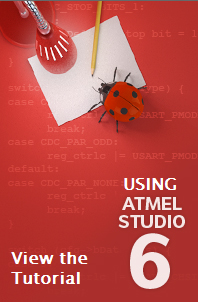

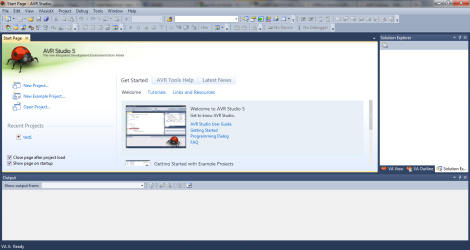
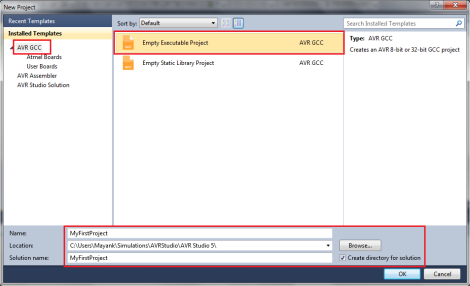
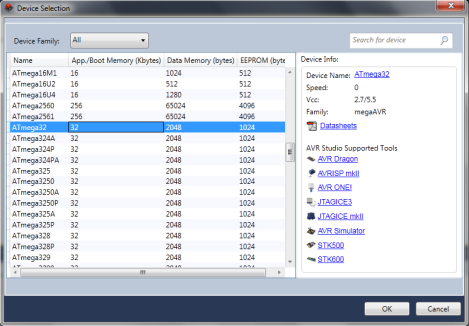

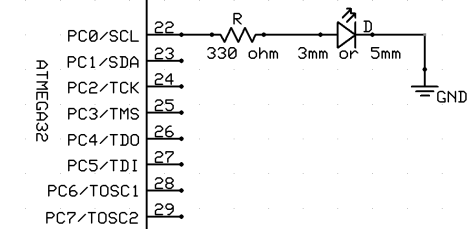
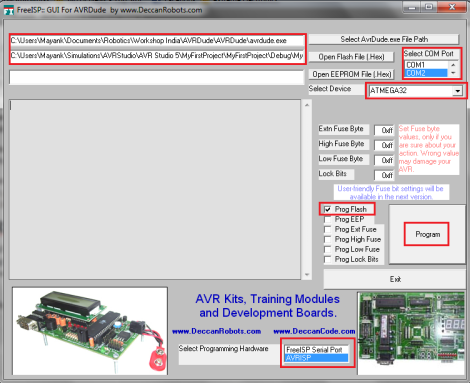
Hi!
I have some problems building the project. This is what I get in the output:
—— Build started: Project: Leds, Configuration: Debug AVR ——
Build started.
Project “Leds.cproj” (default targets):
Target “PreBuildEvent” skipped, due to false condition; (‘$(PreBuildEvent)’!=”) was evaluated as (”!=”).
Target “CoreBuild” in file “C:\Program Files\Atmel\AVR Studio 5.1\Vs\Compiler.targets” from project “\\psf\Home\Documents\AVRStudio 5.1\Leds\Leds\Leds.cproj” (target “Build” depends on it):
Using “RunCompilerTask” task from assembly “C:\Program Files\Atmel\AVR Studio 5.1\Vs\Compiler.Task.dll”.
Task “RunCompilerTask”
C:\Program Files\Atmel\AVR Studio 5.1\make\make.exe all
‘\\psf\Home\Documents\AVRStudio 5.1\Leds\Leds\Debug’
CMD.EXE was started with the above path as the current directory.
UNC paths are not supported. Defaulting to Windows directory.
Leds.c
‘\\psf\Home\Documents\AVRStudio 5.1\Leds\Leds\Debug’
CMD.EXE was started with the above path as the current directory.
UNC paths are not supported. Defaulting to Windows directory.
Invoking: AVR/GNU C Compiler
‘\\psf\Home\Documents\AVRStudio 5.1\Leds\Leds\Debug’
CMD.EXE was started with the above path as the current directory.
UNC paths are not supported. Defaulting to Windows directory.
“C:\Program Files\Atmel\AVR Studio 5.1\extensions\Atmel\AVRGCC\3.3.1.27\AVRToolchain\bin\avr-gcc.exe” -funsigned-char -funsigned-bitfields -O1 -fpack-struct -fshort-enums -g2 -Wall -c -std=gnu99 -MD -MP -MF “Leds.d” -MT”Leds.d” -mmcu=atmega32 -o”Leds.o” “.././Leds.c”
avr-gcc.exe: .././Leds.c: No such file or directory
avr-gcc.exe: no input files
make: *** [Leds.o] Error 1
Done executing task “RunCompilerTask” — FAILED.
Done building target “CoreBuild” in project “Leds.cproj” — FAILED.
Done building project “Leds.cproj” — FAILED.
Build FAILED.
========== Build: 0 succeeded or up-to-date, 1 failed, 0 skipped ==========
Is the problem in the UNC pathing? (I’m using Parallels)
Hope you find some time to look at this problem.
Thanks!
Fred
PS: your tuts are perfect!
AVR Studio doesn’t accept UNC paths, which is a non-Windows path structure (usually used in UNIX OS). Create another project in some other directory, like My Documents (or anywhere having path starting with a drive letter like C:\..\..\.. instead of UNC path like \\CompName\Home\..\..) and make sure you check “Create directory for solution” while creating your project.
Thx. You’re the man! 🙂
Thanks! 😀 😀
Hi, I was thinking how to send messages inside the “Messages List” of AVR Studio. I mean, it could be very useful to write messages during the code compilation, so you can have a look about something like this:
#ifdef _EXTERNAL_CLK
#message External CLK has been defined
#endif
The Preprocessor Message Directive doesn’t work in Atmel AVR Studio 5. Any idea to implement something like that in AVR Studio 5?
Thank you in advance.
Hey Andrea, I am sorry, but I have no idea about this! Kindly post this to avrfreaks.net forum.
Thanks a lot for your answer 😉
hello sir !!
thanks for such a nyc tutorial…
actually i am using atmega644 micro controller and have build the hex code using avr studio5…can u suggest me which burner should i use and the proper fuse configuration…
Hello Nitish
Most of the burners like USBasp, AVRISP, USBtinyISP, etc support ATmega644. You can use any of them.
As far as fuses are concerned, I would suggest you to have a look at http://www.engbedded.com/fusecalc
The fuses for ATmega16 are LOW 0xC9, HIGH 0xFF. Similarly back-calculate the fuses for ATmega644. But be very careful while setting the fuses since they cannot be altered that easily once programmed.
thnks for da reply sir…i was able to burn my controller successfully…
i have one more query… i m using Max233cpp in my circuit…bt when i give supplies,it heats up very fast..i have checked the circuit over and over again bt can’t figure out why ?
Can u suggest any particular reason why ths s happening ??
Hi Nitish
See, with the information you have given me, its impossible for me to detect the error. I suggest you take the multimeter, check for the input/output voltages, check for continuity, etc etc.
I haven’t any development board…..!!
Tell me please which one should I purchase??
Hello
I would suggest you to purchase a cheap one, since you can make one yourself too! eXtreme Electronics offers such boards at an affordable rate. Check it out here. You can get the USBasp programmer from here.
This was just a suggestion. However, you are free to surf different online stores.
xin cảm ơn! thank!
niềm vui của tôi! 🙂
Hi, how can i get only one .hex file from 3 different .c files ? Is there any feature like add or merge in avr studio 5.1 ?
Hi Mohit,
I am afraid, but as far as my knowledge is concerned, there isn’t any such feature in AS5.1. You need to merge them on your own and then build the solution.
is there a software to detect the particular microcontroller we are using , extreme burner is saying power on failed though my green led is lighting and red is blinking, what might be the reason
Hi Amruth,
Seems like you haven’t powered up your microcontroller board. You need to power up your board separately, the USBasp doesn’t supply power to the board.
Hi
There are no errors when i compile the code but I have problem in building my code for driving LCD display I get following errors Please help
Error 1 undefined reference to `Check_IF_LCD_isBusy’
Error 2 undefined reference to `Send_A_String’
Error 3 undefined reference to `Check_IF_LCD_isBusy’
Error 4 undefined reference to `Send_A_Character’
Code is written for atmega 8 and using avr studio5
Hey Ronald,
This is a very vague. You have simply thrown some errors at me, without explaining what you did, how you did, where did you get it, which library you used, and the code itself! I am sorry, but I need more details regarding it before I can try out anything.
BTW, such errors usually pop up when you haven’t added external libraries to your project. Try adding them. You can also refer to my LCD tutorial, however it will be quite different from yours.
I have a problem in AVR studio 6. When it starts building a project , it takes almost 5 minutes to build. What can be th epossible issues with it.
Thanks in advance.
Hi Ravindra,
There can be several issues. What is the length of your code. What type of code have you written? What are your processor specs? Did AS6 get installed properly?
Hi Mayank.
Thanx for the reply.
AS6 was installed properly. Below is the code for testing purpose which is very small :
Code can be found here.
This project is building properly but its taking almost 5 minutes. May be some settings is required before building project but don't have any idea what needs to be done. May be some of the things which are not required are processing.
Did you optimize your code? Once your code is built (even after 5 minutes), is it working the same way as expected in hardware?
I would suggest to go for a fresh installation of AS6. Then follow this tutorial and see if you are able to do it or not.
hello,
i try to write a code for led blinking instead of using predefined delay function ,used a for loop bt it’s nt working and how to find the path of all these predefined function.. pls help
Hi Ritesh,
It would be helpful if you could provide me with some more details regarding your error.
And what kind of path are you searching for?
hello
i have installed avr 5 but can not bulid any project even the examples…!!
— Build started: Project: AVRGCC6, Configuration: Debug AVR ——
========== Build: 0 succeeded or up-to-date, 1 failed, 0 skipped ==========
please guide me
Hi Abm
Please mention the steps that you are following to build a project in AVR 5.
Pingback: How to: Step by step guide to setting up Atmel Studio (AVR Studio 6) for Arduino | aSensar·
Pingback: Step by step guide to setting up Atmel Studio for Arduino development - Inspired by Nature·
This is much better websught for beginers and also designed in beautigully….
Thanks. All the best for your learning process! 🙂
How to add header fike and source file in AVRSTUDIO5
Hemanta, have a look at my LCD tutorial where I have demonstrated one such example. Thanks.
Hi Mayank, pl. also inform (as I use AVR Studio 4 only) & can’t risk disturbing it. If I download AVR Studio 5, will it upgrade AVR4 ? Or will AVR5 remain separate, so that I cn use either one of these as the need be…??
Yes, they’ll be installed as separate entities.
Thanx,..a lot,….- that cleared my doubts..regarding Studio 5, Best Regards.